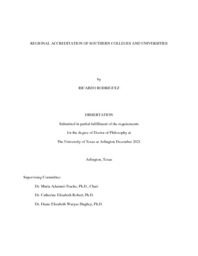
ATTENTION: The works hosted here are being migrated to a new repository that will consolidate resources, improve discoverability, and better show UTA's research impact on the global community. We will update authors as the migration progresses. Please see MavMatrix for more information.
Show simple item record
| dc.contributor.advisor | Trache, Maria A | |
| dc.creator | Rodriguez, Ricardo | |
| dc.date.accessioned | 2022-01-25T18:22:16Z | |
| dc.date.available | 2022-01-25T18:22:16Z | |
| dc.date.created | 2021-12 | |
| dc.date.issued | 2021-12-16 | |
| dc.date.submitted | December 2021 | |
| dc.identifier.uri | http://hdl.handle.net/10106/30212 | |
| dc.description.abstract | Higher education regional accreditation presents problems for colleges and universities in the Southern states. Research on regional accreditation has focused on qualitative approaches to understand how institutions experience accreditation reviews or on quantitative methodologies to examine a single issue of accreditation compliance. However, research has not examined the results of reaffirmation reviews in an entire region and in relation to institutional characteristics. This study aims to examine regional accreditation records of two-year and four-year institutions in the Southern Association of Colleges and Schools Commission on Colleges (SACSCOC) membership to understand the most challenging standards of accreditation and explore the relationship between accreditation noncompliance and institutional characteristics.
Descriptive and inferential statistics were employed to analyze institutions’ accreditation citations as related to selected institutional characteristics. Through a dimensionality reduction, four accreditation standards factors emerged as the most difficult to comply with for the Southern institutions (Institutional Effectiveness, Competence and Performance, Financial Stability, and Student Achievement). However, institutions significantly reduced the number of noncompliance citations by the end of the accreditation review suggesting the effectiveness of the reaffirmation process. Among other results, the size of an institution, in terms of its student enrollment, did not show a relationship to noncompliance with the Institutional Effectiveness, Competence and Performance, and Student Achievement factors; yet, larger institutions were more likely to address Financial Stability noncompliance issues than smaller institutions. Additionally, only institutional characteristics like Type of institution and Graduation rate had a significant effect on the number of accreditation citations received at the initial review stage.
This study contributes to the existing regional accreditation literature by bringing attention to institutional characteristics and their role during a reaffirmation review. Further research is needed in regional accreditation to identify other issues in higher education that hinder institutions from navigating the reaffirmation review process more effectively. | |
| dc.format.mimetype | application/pdf | |
| dc.subject | Institutional effectiveness | |
| dc.subject | Institutional characteristics | |
| dc.subject | Reaffirmation review | |
| dc.subject | Regional accreditation | |
| dc.subject | SACSCOC | |
| dc.title | REGIONAL ACCREDITATION OF SOUTHERN COLLEGES AND UNIVERSITIES | |
| dc.type | Thesis | |
| dc.degree.department | Educational Leadership and Policy Studies | |
| dc.degree.name | Doctor of Philosophy in Educational Leadership and Policy Studies | |
| dc.date.updated | 2022-01-25T18:22:17Z | |
| thesis.degree.department | Educational Leadership and Policy Studies | |
| thesis.degree.grantor | The University of Texas at Arlington | |
| thesis.degree.level | Doctoral | |
| thesis.degree.name | Doctor of Philosophy in Educational Leadership and Policy Studies | |
| dc.type.material | text | |
| dc.creator.orcid | 0000-0002-4683-9595 | |
Files in this item
- Name:
- RODRIGUEZ-DISSERTATION-2021.pdf
- Size:
- 2.511Mb
- Format:
- PDF
This item appears in the following Collection(s)
Show simple item record


